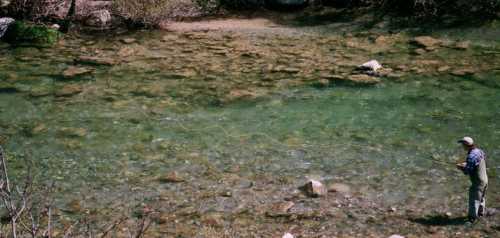This article describes in detail the usefulness, execution and all the possible variants of slack line casts. A detailed comparative analysis will help you discover the advantages and disadvantages of each according to several practical parameters. These tremendously practical casts are easy to apply when you're on the stream and will make your fishing much more productive and fun.

"Come on. You can't be serious. Now that we've finally started making elegant presentations, with the line and the leader neatly stretched out straight, you come along and say that this tidy, straight-line presentation is going to be practically worthless when we're actually fishing." Well, yes. Sorry, but it's absolutely true.
The most important aspect in any passive presentation is, by far, a drag-free drift (except the existence of trout). Drag is still the perennial problem of most fly fishermen independently of whether they fish a dry fly or a nymph (without a strike indicator). They still find it easier to keep changing flies than to learn to execute a certain type of cast Depending on its state of mind, appetite and level of wariness, a trout can gulp just about any pattern, no matter how grotesque it may look. But a trout will never, and this is absolutely irrefutable, take a dragging fly (always referring to passive presentations).
Drag is a much broader and more subtle concept than a fly leaving a wake on the surface of the water. Drag is any sensation of weight or tension, often somewhat more intuitive than physically perceptible (for the fisherman, not for the trout).

I don't know if drag will ever be given its due consideration in angling tactics. Maybe not. It's tedious to totally eliminate drag. After all, we fish to have fun. Nevertheless, that's why some take drag seriously. The pursuit of drag-free drifts can be fascinating and full of curious peculiarities that clench your interest. Try it.
So let's venture forth into this fascinating, complex world of slack line casts so that, from now on, your heaps of line will have a raison d'etre and, what is more important, an intention (after a lousy cast, it's no good claiming, "It's a slack line cast. I love slack line casts.")
We persevering fly fishermen are wont to use this term, which describes an all-too-familiar, despicable phenomenon. We could define it thus:
An aerial as well as aquatic and terrestrial line configuration of debatable esthetics, void of all intentionality and totally barren of symmetry and equilibrium. It serves no purpose and is symptomatic of a poor casting technique and occurs most frequently on windy days, with long casts, in situations of personal stress and after recovering flies hooked on shrubs, branches, twigs and other riparian ornaments.
Alexandria Viñuales, an internationally known fly fishing instructor, gives the following technical explanation.
Drag and nymphing There are two ways to fish a nymph: with and without a strike indicator. And there are two types of strike indicators: those that float and those that are merely visual. With the first type of strike indicator, drag is no problem. With the second type and particularly when sight nymphing, drag is crucial. Even more crucial than fishing the dry fly. Because a submerged nymph moves in an extra plane. A dry fly drags on the horizontal plane. A nymph can drag horizontally and vertically. |
A basic principle of drag says, 'Any stretch of line will contribute to drag only if its relative movement exerts tension on the adjacent stretches.'
As soon as the line lands on the water, the current drags it. Its pattern on the water is quite unimportant (the line doesn't navigate on the water; it's simply dragged by it). It's floatability and hydrophoby are something else. They do make a difference.
To delay this tension, you need to make sure that, wherever the current is faster, the line has slack, since it will travel farther in the same time."
If nothing else works or you're facing an absolutely impossible situation, try one of these tricks. It might work.
- Get much closer to the fish. See if you can reach the target with only a yard or two of line beyond your rod tip. The key lies in overlining your rod (use a line two or three numbers above that of the rod). You'll load the rod as if you had much more line in the air.
- Land your line on a rock. I call this “anchoring the line.” You want only your leader and the last one or two feet of line to fall onto the water. From a certain height, this will automatically create slack. The rest will be suspended between your rod tip and the rock (practice accuracy).
The almost useless straight line
- When you want to transmit some sort of life to your fly (dry, nymph or streamer).
- As a starting point for a lot of presentation casts. It's simpler to apply any kind of pattern or aerial mend to a perfect straight-line cast.
- When you need a very accurate cast with a very long, fine leader (more than 4 yards). In this case, the very design of the leader will create slack near the fly, probably enough for runs and slow waters with very sinuous, almost undecipherable surfaces. Actually, this is the best option in these scenarios.


